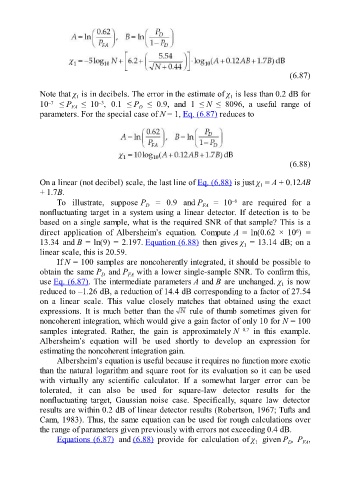Page 481 - Fundamentals of Radar Signal Processing
P. 481
(6.87)
Note that χ is in decibels. The error in the estimate of χ is less than 0.2 dB for
1
1
–3
–7
10 ≤ P ≤ 10 , 0.1 ≤ P ≤ 0.9, and 1 ≤ N ≤ 8096, a useful range of
FA
D
parameters. For the special case of N = 1, Eq. (6.87) reduces to
(6.88)
On a linear (not decibel) scale, the last line of Eq. (6.88) is just χ = A + 0.12AB
1
+ 1.7B.
–6
To illustrate, suppose P = 0.9 and P = 10 are required for a
FA
D
nonfluctuating target in a system using a linear detector. If detection is to be
based on a single sample, what is the required SNR of that sample? This is a
direct application of Albersheim’s equation. Compute A = ln(0.62 × 10 ) =
6
13.34 and B = ln(9) = 2.197. Equation (6.88) then gives χ = 13.14 dB; on a
1
linear scale, this is 20.59.
If N = 100 samples are noncoherently integrated, it should be possible to
obtain the same P and P with a lower single-sample SNR. To confirm this,
FA
D
use Eq. (6.87). The intermediate parameters A and B are unchanged. χ is now
1
reduced to –1.26 dB, a reduction of 14.4 dB corresponding to a factor of 27.54
on a linear scale. This value closely matches that obtained using the exact
expressions. It is much better than the rule of thumb sometimes given for
noncoherent integration, which would give a gain factor of only 10 for N = 100
samples integrated. Rather, the gain is approximately N in this example.
0.7
Albersheim’s equation will be used shortly to develop an expression for
estimating the noncoherent integration gain.
Albersheim’s equation is useful because it requires no function more exotic
than the natural logarithm and square root for its evaluation so it can be used
with virtually any scientific calculator. If a somewhat larger error can be
tolerated, it can also be used for square-law detector results for the
nonfluctuating target, Gaussian noise case. Specifically, square law detector
results are within 0.2 dB of linear detector results (Robertson, 1967; Tufts and
Cann, 1983). Thus, the same equation can be used for rough calculations over
the range of parameters given previously with errors not exceeding 0.4 dB.
Equations (6.87) and (6.88) provide for calculation of χ given P , P ,
FA
1
D

